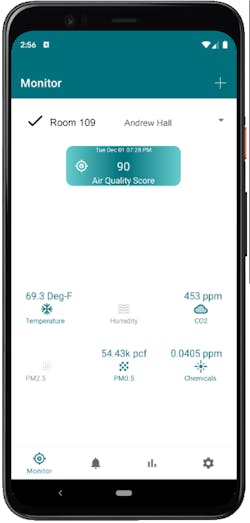COVID-19: Are Building Managers Measuring the Right Air Quality Parameters?
Whether a widely available vaccine for COVID-19 is weeks or months away, workers will soon be coming back to the office. These people will be educated on the dangers of airborne transmission of COVID-19 and understandably concerned about indoor air quality (IAQ). They will look to you—the building owners and facilities managers—for all kinds of reassurances that new systems are now in place to improve IAQ and prevent viral spread.
You need to be able to talk the talk. More importantly, you need to know whether these newly installed prevention measures are working. How do you do that?
Given the stakes, simply providing reassurances is not enough. To provide healthy ventilation, your building must meet science-based standards for IAQ. Otherwise, you’re not doing enough to guard against viral transmission.
So: which IAQ standards—or “parameters”—should your building meet? The answer: the ones that most impact IAQ measurements. There are four. If your building is not measuring, managing and reporting on all four elements, you are not providing adequate protection to your tenants and office staff.
[Related: The Role of Technology in Post-COVID Spaces]
The IAQ Parameters to Know
These are the key IAQ parameters you should know about, each of which must be continually measured and managed.
1. Total Volatile Organic Compounds (TVOCs)
Implementation of sanitization and other enhanced cleaning protocols are a must to facilitate your tenants’ safe return indoors. But be warned: increased cleaning also means increased use of chemicals that often dramatically increase the amount of TVOCs in the air. As the building owner/manager, you should be reviewing TVOC data and ensuring that it’s in an acceptable range. A sensor system is the right tool for this—especially one that identifies any increase of TVOCs from cleaning and sends a signal for more outside air until TVOC levels drop again.
2. Relative Humidity (RH)
When RH is lowered to the 0-40% range, respiratory immune defenses are impaired. At these RH levels, airborne droplets containing viruses evaporate and lighten, allowing the droplets to float longer and survive for a longer period of time.
Due to these issues, your building should work to provide higher relative humidity levels, ideally in the range of 40-60% RH, especially in low humidity/peak viral season.
3. Airborne Particulates
COVID-19, like other viruses, spreads by attaching itself to particles. In the indoor environment, this is especially dangerous and must be minimized. It’s not enough that your building has recently upgraded its filters; the ability to quantify the impact is also imperative.
Filter efficiency is generally lowest between 0.1-0.5 um, which is the most dangerous for coronavirus transmission. Therefore, both small particles and those between 0.5-2.5 should be measured. Using the right data, your building can determine the “effective filtration rate” and whether the healthy small particle levels are being controlled.
4. Carbon Dioxide (CO2)
You must verify that your building is bringing in enough dilution air, and that it has a reliable system to sense the amount of CO2 in the space and bring in more when needed.
The building should also use a high-quality analytics platform to look at CO2 levels of the outside air, supply air and room air. By comparing these readings to science-based air quality standards, you’ll know if the building has adequate ventilation to control CO2 levels.
The Right Information on IAQ
The only truly reliable way to ensure optimal IAQ is by getting the most up-to-date and accurate measurements on each of the parameters referenced above. Accuracy is derived from the system’s architecture and sensors that are calibrated on a regular basis to prevent drift.
There are science-based building standards for each of the parameters, so it’s not just a stab in the dark or a guess. Every building owner/manager should be meeting actual IAQ numbers to provide healthy ventilation that protects against viral transmission. For the sake of your tenants, you should be able to provide information on where your building stands in comparison to these standards immediately. If not, you can’t know whether you’re truly protecting your tenants against airborne transmission.
About the Author: Dan Diehl is the CEO and president of Aircuity.
Read next: How COVID-19 is Changing Future Workplaces



